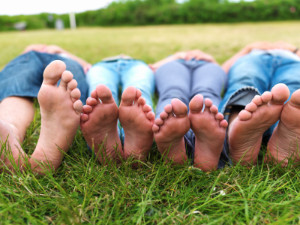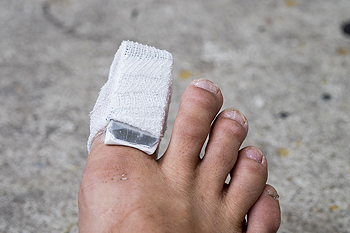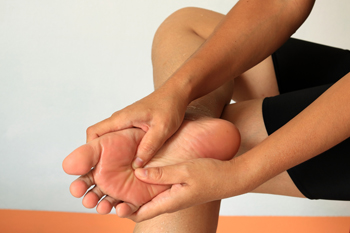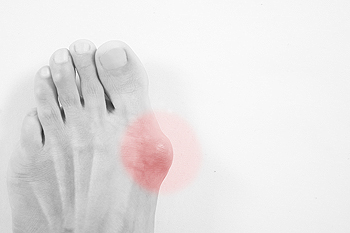Connect With Us
Blog
Items filtered by date: March 2020
Children and Their First Pair of Shoes
 Research has indicated the importance of children wearing shoes that fit properly. This can be achieved by correctly measuring each foot, as this will help you to determine what size shoe is best for your child's feet. Many children walk barefoot while indoors, and this can generally help the feet to become stronger as the toes grasp the floor. When it is time to walk outside, it is beneficial that the shoes are made of breathable materials, in addition to ensure there is adequate room for the toes to move freely in. It is important that shoes fit properly, as this may help to prevent painful foot conditions from developing. If you would like additional information about how to purchase shoes for your child, please consult with a podiatrist.
Research has indicated the importance of children wearing shoes that fit properly. This can be achieved by correctly measuring each foot, as this will help you to determine what size shoe is best for your child's feet. Many children walk barefoot while indoors, and this can generally help the feet to become stronger as the toes grasp the floor. When it is time to walk outside, it is beneficial that the shoes are made of breathable materials, in addition to ensure there is adequate room for the toes to move freely in. It is important that shoes fit properly, as this may help to prevent painful foot conditions from developing. If you would like additional information about how to purchase shoes for your child, please consult with a podiatrist.
The health of a child’s feet is vital to their overall well-being. If you have any questions regarding foot health, contact one of our podiatrists of Family Foot and Ankle Care of Moriches. Our doctors can provide the care you need to keep you pain-free and on your feet.
Tips for Keeping Children's Feet Healthy
- Make sure their shoes fit properly
- Look for any signs of in-toeing or out-toeing
- Check to see if they have Clubfoot (condition that affects your child’s foot and ankle, twisting the heel and toes inward) which is one of the most common nonmajor birth defects.
- Lightly cover your baby’s feet (Tight covers may keep your baby from moving their feet freely, and could prevent normal development)
- Allow your toddler to go shoeless (Shoes can be restricting for a young child’s foot)
- Cut toenails straight across to avoid ingrown toenails
- Keep your child’s foot clean and dry
- Cover cuts and scrapes. Wash any scratches with soap and water and cover them with a bandage until they’ve healed.
If you have any questions, please feel free to contact our offices located in Moriches and Shirley, NY . We offer the newest diagnostic and treatment technologies for all your foot care needs.
How Do You Get a Broken Toe?
 The bones that are in each toe are generally fragile. If a heavy object falls on one or more of your toes, this could result in a broken toe. Additionally, a broken toe may occur if your toe is stubbed against a piece of furniture. Immediate symptoms can often include severe pain and discomfort, swelling, and the toe may turn black and blue. It may help to reduce swelling by keeping the affected foot elevated, and walking as little as possible. An effective treatment method for toes that are mildly broken is referred to as “buddy taping”. This is done by taping the fractured toe to the toe next to it. This technique can be beneficial in providing the necessary support as the healing process takes place. If you feel you have broken your toe, please consult with a podiatrist who can offer the correct treatment options for you.
The bones that are in each toe are generally fragile. If a heavy object falls on one or more of your toes, this could result in a broken toe. Additionally, a broken toe may occur if your toe is stubbed against a piece of furniture. Immediate symptoms can often include severe pain and discomfort, swelling, and the toe may turn black and blue. It may help to reduce swelling by keeping the affected foot elevated, and walking as little as possible. An effective treatment method for toes that are mildly broken is referred to as “buddy taping”. This is done by taping the fractured toe to the toe next to it. This technique can be beneficial in providing the necessary support as the healing process takes place. If you feel you have broken your toe, please consult with a podiatrist who can offer the correct treatment options for you.
A broken toe can be very painful and lead to complications if not properly fixed. If you have any concerns about your feet, contact one of our podiatrists from Family Foot and Ankle Care of Moriches. Our doctors will treat your foot and ankle needs.
What to Know About a Broken Toe
Although most people try to avoid foot trauma such as banging, stubbing, or dropping heavy objects on their feet, the unfortunate fact is that it is a common occurrence. Given the fact that toes are positioned in front of the feet, they typically sustain the brunt of such trauma. When trauma occurs to a toe, the result can be a painful break (fracture).
Symptoms of a Broken Toe
- Throbbing pain
- Swelling
- Bruising on the skin and toenail
- The inability to move the toe
- Toe appears crooked or disfigured
- Tingling or numbness in the toe
Generally, it is best to stay off of the injured toe with the affected foot elevated.
Severe toe fractures may be treated with a splint, cast, and in some cases, minor surgery. Due to its position and the pressure it endures with daily activity, future complications can occur if the big toe is not properly treated.
If you have any questions please feel free to contact our offices located in Moriches and Shirley, NY . We offer the newest diagnostic and treatment technologies for all your foot and ankle needs.
Chair Yoga May Help to Stretch the Feet
 A form of stretching, which is referred to as chair yoga, may be beneficial to practice after sitting and standing for extended periods of time. It can be helpful to stretch the feet in a classroom environment, which can be accomplished by a variety of methods. Heel raises are performed while keeping both heels flat on the floor, and lifting one heel at a time. After holding this position for a few seconds, repeat with the other foot. When the toes and feet are flexible, it may lead to easing tension in the shoulders and neck. This can be a result of utilizing the reflex zones that are located in the feet, and is accomplished by clenching the toes and soles of the feet, and then relaxing them. If you would like additional information about the benefits of stretching the feet, it is suggested that you speak to a podiatrist.
A form of stretching, which is referred to as chair yoga, may be beneficial to practice after sitting and standing for extended periods of time. It can be helpful to stretch the feet in a classroom environment, which can be accomplished by a variety of methods. Heel raises are performed while keeping both heels flat on the floor, and lifting one heel at a time. After holding this position for a few seconds, repeat with the other foot. When the toes and feet are flexible, it may lead to easing tension in the shoulders and neck. This can be a result of utilizing the reflex zones that are located in the feet, and is accomplished by clenching the toes and soles of the feet, and then relaxing them. If you would like additional information about the benefits of stretching the feet, it is suggested that you speak to a podiatrist.
Why Stretching Is Important for Your Feet
Stretching the feet is a great way to prevent injuries. If you have any concerns with your feet consult with one of our podiatrists from Family Foot and Ankle Care of Moriches. Our doctors will assess your condition and provide you with quality foot and ankle treatment.
Stretching the Feet
Stretching the muscles in the foot is an important part in any physical activity. Feet that are tight can lead to less flexibility and make you more prone to injury. One of the most common forms of foot pain, plantar fasciitis, can be stretched out to help ease the pain. Stretching can not only ease pain from plantar fasciitis but also prevent it as well. However, it is important to see a podiatrist first to determine if stretching is right for you. Podiatrists can also recommend other ways to stretch your feet. Once you know whether stretching is right for you, here are some excellent stretches you can do.
- Using a foam roller or any cylindrical object (a water bottle or soda can will do), roll the object under your foot back and forth. You should also exert pressure on the object. Be sure to do this to both feet for a minute. Do this exercise three times each.
- Similar to the previous exercise, take a ball, such as a tennis ball, and roll it under your foot while seated and exert pressure on it.
- Grab a resistance band or towel and take a seat. If you are using a towel, fold it length wise. Next put either one between the ball of your foot and heel and pull with both hands on each side towards you. Hold this for 15 seconds and then switch feet. Do this three times for each foot.
- Finally hold your big toe while crossing one leg over the other. Pull the toe towards you and hold for 15 seconds. Once again do this three times per foot.
It is best to go easy when first stretching your foot and work your way up. If your foot starts hurting, stop exercising to ice and rest the foot. It is advised that you then see a podiatrist for help.
If you have any questions, please feel free to contact our offices located in Moriches and Shirley, NY . We offer the newest diagnostic and treatment technologies for all your foot care needs.
Arthritis Can Cause Pain in the Feet and Ankles
How to Tell If You Have Developed Peripheral Artery Disease
 The condition known as Peripheral Artery Disease, or “PAD” for short, is typical among diabetic patients. The risk of getting PAD may also increase with age, as well as for those who have high blood pressure or high cholesterol. PAD can affect different parts of the body, the feet being a common area. Symptoms of this condition may include a lack of feeling in the feet, as well as a stinging, burning, or tingling sensation. Some patients have also noticed difficulty walking, discoloration of the affected area, and sores or ulcers. If you believe you are afflicted with this condition it is important that you seek the counsel of a podiatrist as soon as possible. If left untreated, this ailment could worsen and in severe cases, may lead to limb loss. For more information on PAD, and for a proper diagnosis, it is highly recommended that you consult with a podiatrist right away.
The condition known as Peripheral Artery Disease, or “PAD” for short, is typical among diabetic patients. The risk of getting PAD may also increase with age, as well as for those who have high blood pressure or high cholesterol. PAD can affect different parts of the body, the feet being a common area. Symptoms of this condition may include a lack of feeling in the feet, as well as a stinging, burning, or tingling sensation. Some patients have also noticed difficulty walking, discoloration of the affected area, and sores or ulcers. If you believe you are afflicted with this condition it is important that you seek the counsel of a podiatrist as soon as possible. If left untreated, this ailment could worsen and in severe cases, may lead to limb loss. For more information on PAD, and for a proper diagnosis, it is highly recommended that you consult with a podiatrist right away.
Peripheral artery disease can pose a serious risk to your health. It can increase the risk of stroke and heart attack. If you have symptoms of peripheral artery disease, consult with one of our podiatrists from Family Foot and Ankle Care of Moriches. Our doctors will assess your condition and provide you with quality foot and ankle treatment.
Peripheral artery disease (PAD) is when arteries are constricted due to plaque (fatty deposits) build-up. This results in less blood flow to the legs and other extremities. The main cause of PAD is atherosclerosis, in which plaque builds up in the arteries.
Symptoms
Symptoms of PAD include:
- Claudication (leg pain from walking)
- Numbness in legs
- Decrease in growth of leg hair and toenails
- Paleness of the skin
- Erectile dysfunction
- Sores and wounds on legs and feet that won’t heal
- Coldness in one leg
It is important to note that a majority of individuals never show any symptoms of PAD.
Diagnosis
While PAD occurs in the legs and arteries, Podiatrists can diagnose PAD. Podiatrists utilize a test called an ankle-brachial index (ABI). An ABI test compares blood pressure in your arm to you ankle to see if any abnormality occurs. Ultrasound and imaging devices may also be used.
Treatment
Fortunately, lifestyle changes such as maintaining a healthy diet, exercising, managing cholesterol and blood sugar levels, and quitting smoking, can all treat PAD. Medications that prevent clots from occurring can be prescribed. Finally, in some cases, surgery may be recommended.
If you have any questions, please feel free to contact our offices located in Moriches and Shirley, NY . We offer the newest diagnostic and treatment technologies for all your foot care needs.
Possible Causes of Bunions
 Patients who have developed bunions are often aware of the pain and discomfort they may cause. A bunion appears as a bony protrusion on the side of the big toe, and it may be difficult to wear shoes. Some of the symptoms that are associated with bunions can consist of redness and swelling on the bottom of the big toe, and the second toe may overlap the big toe. Genetic factors may play a significant role in developing bunions, in addition to wearing shoes that do not have adequate room for the toes to move freely in. Some patients may have existing medical conditions that can increase the risk of obtaining a bunion, such as flat feet, or neuromuscular conditions. It may be beneficial to wear custom made orthotics which may help to relieve some of the pressure that bunions can cause. If you have developed a bunion, please consult with a podiatrist who can help you to manage this ailment.
Patients who have developed bunions are often aware of the pain and discomfort they may cause. A bunion appears as a bony protrusion on the side of the big toe, and it may be difficult to wear shoes. Some of the symptoms that are associated with bunions can consist of redness and swelling on the bottom of the big toe, and the second toe may overlap the big toe. Genetic factors may play a significant role in developing bunions, in addition to wearing shoes that do not have adequate room for the toes to move freely in. Some patients may have existing medical conditions that can increase the risk of obtaining a bunion, such as flat feet, or neuromuscular conditions. It may be beneficial to wear custom made orthotics which may help to relieve some of the pressure that bunions can cause. If you have developed a bunion, please consult with a podiatrist who can help you to manage this ailment.
If you are suffering from bunions, contact one of our podiatrists of Family Foot and Ankle Care of Moriches. Our doctors can provide the care you need to keep you pain-free and on your feet.
What Is a Bunion?
A bunion is formed of swollen tissue or an enlargement of boney growth, usually located at the base joint of the toe that connects to the foot. The swelling occurs due to the bones in the big toe shifting inward, which impacts the other toes of the foot. This causes the area around the base of the big toe to become inflamed and painful.
Why Do Bunions Form?
Genetics – Susceptibility to bunions are often hereditary
Stress on the feet – Poorly fitted and uncomfortable footwear that places stress on feet, such as heels, can worsen existing bunions
How Are Bunions Diagnosed?
Doctors often perform two tests – blood tests and x-rays – when trying to diagnose bunions, especially in the early stages of development. Blood tests help determine if the foot pain is being caused by something else, such as arthritis, while x-rays provide a clear picture of your bone structure to your doctor.
How Are Bunions Treated?
- Refrain from wearing heels or similar shoes that cause discomfort
- Select wider shoes that can provide more comfort and reduce pain
- Anti-inflammatory and pain management drugs
- Orthotics or foot inserts
- Surgery
If you have any questions, please feel free to contact our offices located in Moriches and Shirley, NY . We offer the newest diagnostic and treatment technologies for all your foot care needs.
Blog Archives
- March 2025
- February 2025
- January 2025
- December 2024
- November 2024
- October 2024
- September 2024
- August 2024
- July 2024
- June 2024
- May 2024
- April 2024
- March 2024
- February 2024
- January 2024
- December 2023
- November 2023
- October 2023
- September 2023
- August 2023
- July 2023
- June 2023
- May 2023
- April 2023
- March 2023
- February 2023
- January 2023
- December 2022
- November 2022
- October 2022
- September 2022
- August 2022
- July 2022
- June 2022
- May 2022
- April 2022
- March 2022
- February 2022
- January 2022
- December 2021
- November 2021
- October 2021
- September 2021
- August 2021
- July 2021
- June 2021
- May 2021
- April 2021
- March 2021
- February 2021
- January 2021
- December 2020
- November 2020
- October 2020
- September 2020
- August 2020
- July 2020
- June 2020
- May 2020
- April 2020
- March 2020
- February 2020
- January 2020
- December 2019
- November 2019
- October 2019
- September 2019
- August 2019
- July 2019
- June 2019
- May 2019
- April 2019
- March 2019
- February 2019
- January 2019
- December 2018
- November 2018
- October 2018
- September 2018
- August 2018
- July 2018
- June 2018
- May 2018
- April 2018
- March 2018
- February 2018
- January 2018
- December 2017
- November 2017
- October 2017
- September 2017
- August 2017
- July 2017
- June 2017
- May 2017
- April 2017
- March 2017
- February 2017
- January 2017
- December 2016
- November 2016
- October 2016
- September 2016
- August 2016
- July 2016
- June 2016
- October 2015
- September 2015
- August 2015
- July 2015
- June 2015
- May 2015
- April 2015




